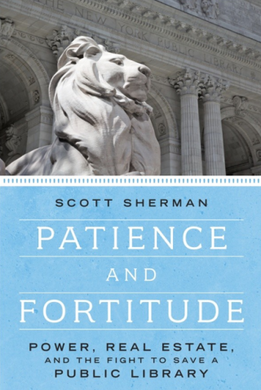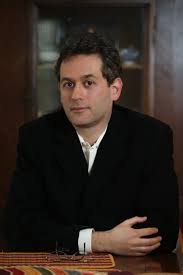Saving the New York Public Library: An Interview with Scott Sherman
Today on Gotham, editor Nick Juravich interviews Scott Sherman about his new book, Patience and Fortitude, and the fight to save the New York Public Library.
Thanks for sitting down with us, Scott. Why don't you start by telling us about your own relationship to the New York Public Library?
I moved to New York City in 1991, and four years later decided to launch a career as freelance writer. Looking for a place to work, I began to frequent the grand library at 42nd Street and Fifth Avenue, which soon became my second home. Most of the day I worked in the Rose Reading Room, and then I retreated to the Periodicals Room to look at the day’s newspapers. I loved the building: the slanting light in the Rose Reading Room; the majestic staircases; the eccentric cast of characters at the long wooden tables; and — most of all — the fact that there were three million books in the seven levels of dense stacks directly beneath the Rose Reading Room. Most books could usually reach me in two hours or less. It was bliss.
Okay, now to the headline: tell us about the controversy at the NYPL.
One morning in the spring of 2010, I was approached by a librarian I had known slightly for years. He was familiar with The Nation and knew I wrote for it; he also liked to chat. To my surprise, he leaned over and whispered into my ear: “Our trustees are planning to sell the library across the street” — by which he meant the Mid-Manhattan Library, a decrepit facility on 40th Street and Fifth Avenue. “It stinks,” he continued. “You should look into it. Do it soon.”
I was busy with other projects, and let his tip go. But a year later I was offered a chance to profile Tony Marx, the incoming president of the NYPL. Two weeks into my research, I immediately grasped what the librarian had tried to tell me a year earlier: the NYPL’s trustees — aided by Booz Allen, a corporate consulting firm — had conceived a grandiose renovation plan. The 42nd Street library would undergo a renovation in which the three million books would be sent to an offsite storage facility in New Jersey. The old stacks (which are a marvel of engineering), would be demolished and a new, modern library would be built in the space that, for a century, had held the books. The price tag for this was $300 million. To cover the costs of this Central Library Plan (CLP), two nearby libraries would be sold: the Mid-Manhattan Library and the Science, Industry and Business Library on 34th Street.
The whole scheme was a castle in the sky — a doomed plan by library trustees who were indifferent to books, public space and scholarly research, and who were determined that the NYPL should get its share of the spoils from a soaring Manhattan real estate market. The CLP was immediately contested by a small group of citizens — historic preservationists, bookworms, retired librarians, writers, grassroots organizers — who fought the plan for two years and, in the end, built a diverse coalition against the NYPL. They convinced the new mayor, Bill de Blasio, that the plan was ill-conceived, and in early 2014 de Blasio told the NYPL it could not proceed with the sale of a major public asset — the Mid-Manhattan Library. That library is now undergoing a $500 million renovation, a triumph for the activists and for all New Yorkers. The activists also saved the old stacks at the 42nd Street library.
The aborted CLP cost the NYPL, by its estimate, $18 million. My own estimate is much higher. NYPL’s architect, Norman Foster, kept $9 million for a renovation that was never undertaken. It was too late to rescue the beloved Donnell Library, on 53rd Street, which was sold off, for a pittance, in the earliest phase of the CLP in 2008, three years before the public learned about the plan.
You first reported this story in The Nation, and then expanded on it for Patience and Fortitude. What sources did you use to build the narrative?
First I contacted former and current staff members. When I approached one librarian for an interview, he replied with some irritation: “I can’t do an official interview with you, since my bosses would skin me. But if you invite me out to lunch, I won’t say no. I can eat lunch with anyone I choose to!” We went to an Irish pub around the corner and he unleashed a torrent of criticism, concluding: “The whole building is a single architectural masterpiece. The CLP would basically destroy half the library.” He was just one of many people at the NYPL who spoke with me.
When I expanded the article into a book, I read Phyllis Dain’s history of the NYPL. It was published by the Library in 1972, but it’s an independent work of scholarship. There are some fine, charming, mid-century memoirs written by senior NYPL librarians. Philip Hamburger’s two-part New Yorker profile of Vartan Gregorian, who led the NYPL in the 1980s, finely evoked the Library’s internal culture and atmosphere. I was dependent on the archive of The New York Times and astonished to see how deeply the Times had reported on the entire NYPL system — not just the four research libraries, but the many branch libraries around the city. Starting in the 1950s, the Times produced between fifty and a hundred stories a year about the NYPL, every year. I found the Times’s online database cumbersome to use, so I relied on the bulky red hardcover volumes of the Times Index,which never failed me.
Under New York State law, public libraries must surrender their trustee meeting minutes. I relied on those printed minutes for my Nationreporting. They were oblique and fragmented, but provided me with facts, dates and further paths of exploration; studying them, I experienced some of the excitement that historians must feel in the archives. When I started writing Patience and Fortitude, I obtained the minutes of the NYPL’s executive committee, which is where the real power resides. Many NYPL trustees were disengaged from the nitty-gritty of the CLP; the most powerful trustees, though, sat on the executive committee, and I learned a lot from the minutes of their closed sessions. I also attended the trustee meetings, which are open to the public, although guests are expelled from the room when the board goes into “executive session.”
So, tell us more about the role writers, intellectuals and historians played in this war.
The CLP was announced at a 2008 press conference featuring longtime trustee Toni Morrison. I suspect that the NYPL’s then-president, Paul LeClerc, gave Morrison an incomplete account of what the CLP would eventually entail. I can’t be sure of this: LeClerc and Morrison declined to speak with me. Real estate developers, hedge-fund managers and wealthy individuals dominate the NYPL board, but the board also contains many prominent writers and editors. At the time of my reporting, the most prominent intellectual was Robert Darnton, who was the only trustee who communicated with me — on the record — throughout the period 2011-14, when the controversy was raging. At first, Darnton was a loud advocate of the CLP, but he later came to feel that the critics were right. I chronicled his trajectory in Patience and Fortitude.
Some of my interactions with NYPL trustees were extremely strange. At a trustee meeting in Harlem in 2013, I introduced myself to Henry Louis Gates Jr. and asked him for his thoughts on the CLP, which had become very controversial. He glared at me, leaned over, and whispered into my ear: “You don’t want any trouble, do you, guy?” Then, with a beaming smile, he turned his back and greeted his fellow trustees.
Historians were notably active in the battle against the CLP: Joan Scott, Stanley Katz, David Nasaw, David Levering Lewis, Anthony Grafton, Elizabeth A.R. Brown, Edmund Morris, Thomas Bender, Cynthia Pyle, Blanche Cook. As the controversy was winding down, E.L. Doctorow and Art Spiegelman produced acidic critiques of the CLP. Annalyn Swan, who, with her husband, Mark Stevens, won a Pulitzer for a biography of Willem de Kooning, was also deeply involved in the defense of the NYPL, and remains so today.
Not long ago, the commentator Matt Yglesias shot off a half-snarky, half serious tweet about how “If they didn’t already exist, public libraries would strike people as the most outlandish left-wing idea.” There seems to be a grain of truth in there somewhere. What do you think?
The people who designed and built the 42nd Street Library from 1895-1911 were not left-wingers. The Library was, in large part, the creation of John Shaw Billings, a physician who served as an army surgeon during the Civil War. Billings was a polymath whose interests included hospital construction, sanitary engineering and medical bibliography. Phyllis Dain called him “probably the most versatile librarian the United States has produced.” In that era, the Library’s board consisted of men like Lewis Ledyard, J.P. Morgan’s lawyer and Edith Wharton’s cousin. Ledyard and his fellow trustees were pillars of the Manhattan establishment who were determined to create a library in New York as great as the British Museum. Certainly there were utopian elements in that scheme: the trustees wanted the NYPL to contain the world’s most outstanding books, manuscript collections and printed materials. To a great extent they succeeded.
Today, it is unwise to talk about public libraries in left-right terms; a great many Republicans are devoted to libraries. Librarians themselves have a sense of duty that transcends politics and ideology.
You’ve written about the neglect of the NYPL’s branch libraries. Update us on their condition.
The NYPL is structurally complex: it operates four research libraries and nearly one hundred branch libraries. Four different entities are responsible for the upkeep of the neighborhood libraries: the NYPL, the Mayor, the City Council and private philanthropists. It’s an inefficient system. A lot depends on what individual Council members can and will do, and the wealth of a given neighborhood. SoHo has a modern, attractive, high-functioning branch library, but East Harlem does not. Lately the NYPL has made a real effort to improve some of the branch libraries: they did an admirable job renovating the branch on 160th Street in Washington Heights. But the branch libraries in the Bronx are in very poor condition.
Library users, all over the city, must exert pressure on their elected officials to spend money on the branch libraries. Those users should not sit back and wait for the library activists, whose numbers are small, to do that gritty political work for them.
Where do matters stand with regard to the stacks at the 42nd Street Library?
Three million books were quietly emptied from the stacks in 2012 and 2013 to make way for a renovation that never occurred. It happened under a cloak of secrecy. Today, the stacks are mostly empty. I hope the NYPL takes the high road and returns those three million volumes to their original home. Some NYPL-watchers are optimistic that the books will come back. David Nasaw recently told me that “this piece of midtown real estate is too valuable to stay empty.” I hope he is right.


